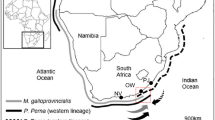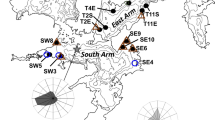Summary
Growth studies in M. edulis L. have shown that rates vary considerably according to age, size and environmental conditions. This may in part be attributed to its sessile habit, being unable to move away from the variable external conditions.
The use of modal length frequency distributions is somewhat limited, since with three or more year groups represented, the growth of the majority of the population is so slow that individual year classes lose their identity. Growth boxes, containing marked animals of different ages, and set out in a variety of habitats gave information regarding local and seasonal growth rates. Disturbance rings were shown to be annual, and from them growth curves have been constructed.
Growth is particularly seasonal, little or none occurring during the winter. Growth rates varied considerably with a variety of environmental factors (both biotic and physical) and some of these are discussed. Variable individual growth rates, together with slow growth of the majority of animals in mixed populations, are perhaps the major factors in producing population structures typical of this species on open shores.
Survivorship curves for mussels in a variety of habitats have been constructed by following the survival of groups of marked animals. Whilst high mortalities occurred in the mid and low shore, survival in the upper shore in the absence of major predators, was greatly enhanced, resulting in established populations of considerable age. Periods of maximum mortality during spring and summer could be correlated with the abundance of major predators.
The almost cosmopolitan distribution of M. edulis in the N. hemisphere has been made possible by virtue of its high reproductive capacity, successful larval dispersion and wide tolerance of environmental conditions, Its patchy and apparently erratic distribution both from one shore to annother and even on the same shore, is greatly influenced by the local and seasonal abundance of major predators. Whilst the upward extension of mussels is prevented, ultimately, by physical factors (e.g. temperature, dessication), its lower limits (and absence from the shallow sub littoral on many shores) are governed essentially by predators. The upward extension of many predators such as crabs or starfish, resulting in locally intense predation, may in turn be partly influenced by the actual topography of the shore itself.
Similar content being viewed by others
References
Abeloos, M.: Recherches expérimentales sur la croissance. La croissance des Mollusques arionidés, Bull. biol. France et Belg. 78, 215–256 (1944).
Bayne, B. L.: Growth and delay of metamorphosis of the larvae of Mytilus edulis. Ophelia 2 (1), 1–47, (1965).
Böetius, I.: Temperature and growth of Mytilus edulis (L.) from the N. Harbour of Copenhagen (The Sound). Meddr. Danm. Fisk.-og Havunders, N.S. 3 (II), 339–346 (1962).
Chanley, P. E.: Possible causes of growth variations in clam larvae. Proc. nat. Shellfish. Ass. 45, 84–94 (1955).
Coe, W. R.: Nutrition and growth of the Californian bay mussel Mytilus edulis diegensis. J. exp. Zool. 99, 1–14 (1945).
—, and D. L. Fox: Biology of the Californian Sea mussel (Mytilus californianus). I Influence of temperature, food supply, sex and age on the rate of growth. J. exp. Zool. 90, 1–30 (1942).
Cole, H. A.: On some larval Trematode parasites of the mussel (Mytilus edulis) and the cockle (Cardium edule). Parasitology 27, 276–285 (1935).
Connell, J. H.: Effects of competition, predation by Thais lapillus, and other factors, on natural populations of the barnacle Balanus balanoides. Ecol. Monogr. 31, 61–104 (1961).
Coulthard, H.S.: Growth of the sea mussel. Contr. Can. Biol. Fish., N.S. 4, 121–136 (1929).
Deevey, E. S.: Life tables for natural populations of animals. Quart. Rev. Biol. 22, 282–314 (1947).
Drinnan, R. E.: The winter feeding of the oystercatcher (Haematopus ostralegus) on the edible mussel (Mytilus edulis) in the Conway Estuary, N. Wales. Fishery Invest. (Lond.), Ser. II 22 (4), 1–15 (1957)
Ebling, F. J., J. A. Kitching, L. Muntz, and C. M. Taylor: The ecology of L. Ine 13 Experimental observations of the destruction of M. edulis and Nucella lapillus by crabs. J. Anim. Ecol. 33, 73–82 (1964).
Feare, C. J.: Winter feeding of the Purple Sandpiper. Br. Birds 59, 165–179 (1966).
Fischer-Piette, E.: Histoire d'une Moulière. Bull. biol. France et Belg. 69 (2), 153–177 (1935).
Ford, E.: On the growth of some lamellibranchs in relation to food supply of fishes. J. mar. biol. Ass. U.K. 13, 531 (1925)
Fox, D. L., and W. R. Coe: Biology of the Californian sea mussel (Mytilus californianus) II Nutrition, metabolism, growth and calcium deposition. J. exp. Zool. 93 (2), 205–249 (1943).
—, H. O. Sverdrup, and J.P. Cunningham: The rate of water propulsion by the Californian sea mussel. Biol. Bull. mar. biol. Lab., Wood's Hole, 72, 417–439 (1937).
Green, J.: The growth of Scrobicularia plana (da Costa) in the Gwendraeth estuary. J. mar. biol. Ass. U.K. 36, 41–47 (1957).
Hancock, D.A., and A. E. Urquhart: The determination of natural mortality and its causes in an exploited population of cockles (Cardium edule L.). Fishery Invest. (Lond.), Ser. II, 24 (2) (1965).
Hatton, H.: Essais de bionomie explicative sur quelques espèces intercotidales d'algues et d'animaux. Ann. Inst. océanogr. (Monaco) 17, 241–348 (1938).
Jørgensen, C. B.: The rate of feeding by Mytilus in different kinds of suspension. J. mar. biol. Ass. U.K. 28, 333–344 (1949)
Kitching, J. A., J. F. Sloane, and F.J. Ebling: The Ecology of L.Ine 8 Mussels and their predators. J. Anim. Ecol. 28, 331–341 (1959).
Mason, J.: The age and growth of the scallop (Pecten maximus L.) in Manx waters. J. mar. biol. Ass. U.K. 36, 473–492 (1957).
Mateeva, T. A.: The biology of Mytilus edulis in E. Murman. Trudy murmansk biol. Inst. 1, 215–241 (1948).
Moore, H. B.: The biology of Purpura lapillus. Pt. II. Growth J. mar. biol. Ass. U.K. 23 57–66 (1938).
Mossop, B. K. E.: The rate of growth of the sea mussel (Mytilus edulis) at St. Andrews New Brunswick, Digby Nova Scotia and in Hudson Bay. Trans. Can. Inst. 14, 3–22 (1922).
Naylor, E.: Seasonal changes in the population of Carcinus maenas in the littoral zone. J. Anim. Ecol. 31, 601–609 (1962).
Negus, C. L.: A Quantitative study of growth and production of Unionid mussels in the River Thames at Reading. J. Anim. Ecol. 35 (3), 513–533 (1966).
Pearl, R., and J. R. Miner: Experimental studies on the duration of life. 14. The comparative mortality of lower organisms. Quart. Rev. Biol. 10, 60–79 (1935).
Posgay, J. A.: The Sea scallop fishery. 6th Report on Investigations of the Shell-fisheries of Massachusetts. Boston: Comm. Mass., Dept. nat. Resour. Div. mar. Fish. (1953).
Richards, O.W.: The growth of the mussel, Mytilus edulis at Wood's Hole Mass. Natilus 41, 99–101 (1928).
Rothschild, M.: Gigantism and variation in Peringia ulvae Pennant caused by larval Trematodes. J. mar. biol. Ass. U.K. 20, 537–546 (1936).
Savage, R. E.: The great spatfall of mussels in the River Conway Estuary in spring 1940. Fishery Invest. (Lond.), Ser. II 20 (7), 1–21 (1956).
Seed, R.: The Ecology of Mytilus edulis L. (Lamellibranchiata) on exposed rocky shores. Part I: Breeding and settlement. Oecologia (Berl.) 3, 277–316 (1969).
Segerstråle, S.G.: Investigations on Baltic populations of the bivalve Macoma baltica (L). Commentat. biol. 23 (2), 1–72 (1960).
Tang, S. F.: The breeding of the escallop (Pecten maximus L.) with a note on the growth rate. Proc. Trans. Lpool biol. Soc. 54, 9–28 (1941).
Theede, H.: Experimentelle Untersuchungen über die Filtrationsleistung der Miesmuschel M. edulis (L). Kieler Meeresforsch. 19 (1), 20–41 (1963).
Tinbergen, N., and M. Norton Griffiths: Oystercatchers and mussels. Br. Birds 57 (2), 64–70 (1964).
Walne, P. R.: Growth of oysters (Ostrea edulis L.). J. mar. biol. Ass. U.K. 37, 591–602 (1958).
— Observations on the mortality of Ostrea edulis L. J. mar. biol. Ass. U.K. 41, 113–122 (1961).
Weymouth, F. W.: The life history and growth of the Pismo clam Tivela stultorum (Mawe). Bull. Dep. Fish Game St. Calif., No 7 (1923).
Wiborg, K. F.: Undersøkelser overoskjellet (Modiola modiolus L.) Rep. Norw. Fishery mar. Invest. 8 (5), 1–85 (1946).
Wilbur, K. M., and G. Owen: Growth. In: Physiology of Mollusca, vol. I, p. 211–242 (ed. K. M. Wilbur and C. M. Yonge). New York: Acad. Press (1964).
Winckworth, R.: On the growth of Paphia undulata. Proc. malac. Soc. Lond. 19, 171–174 (1931).
Zeuthen, E.: Body size and metabolic rate in the animal kingdom with special regard to the marine microfauna. C. R. Trav. Lab. Carlsberg, Sér. Chim. 26, 17–161 (1947).
Author information
Authors and Affiliations
Rights and permissions
About this article
Cite this article
Seed, R. The ecology of Mytilus edulis L. (Lamellibranchiata) on exposed rocky shores. Oecologia 3, 317–350 (1969). https://doi.org/10.1007/BF00390381
Received:
Issue Date:
DOI: https://doi.org/10.1007/BF00390381




